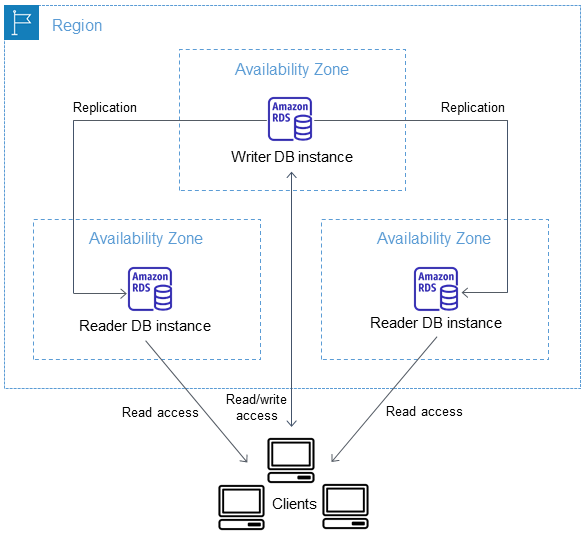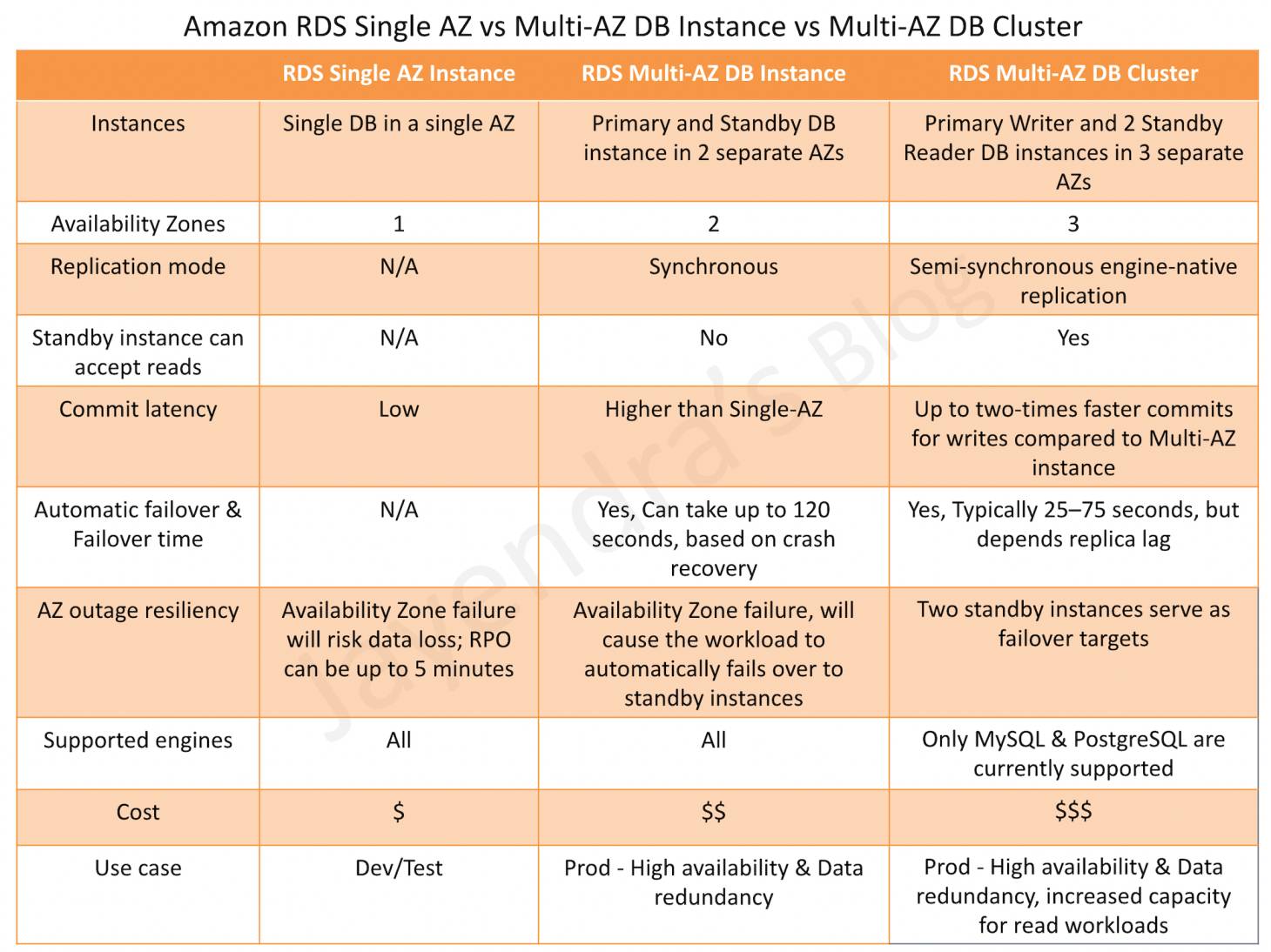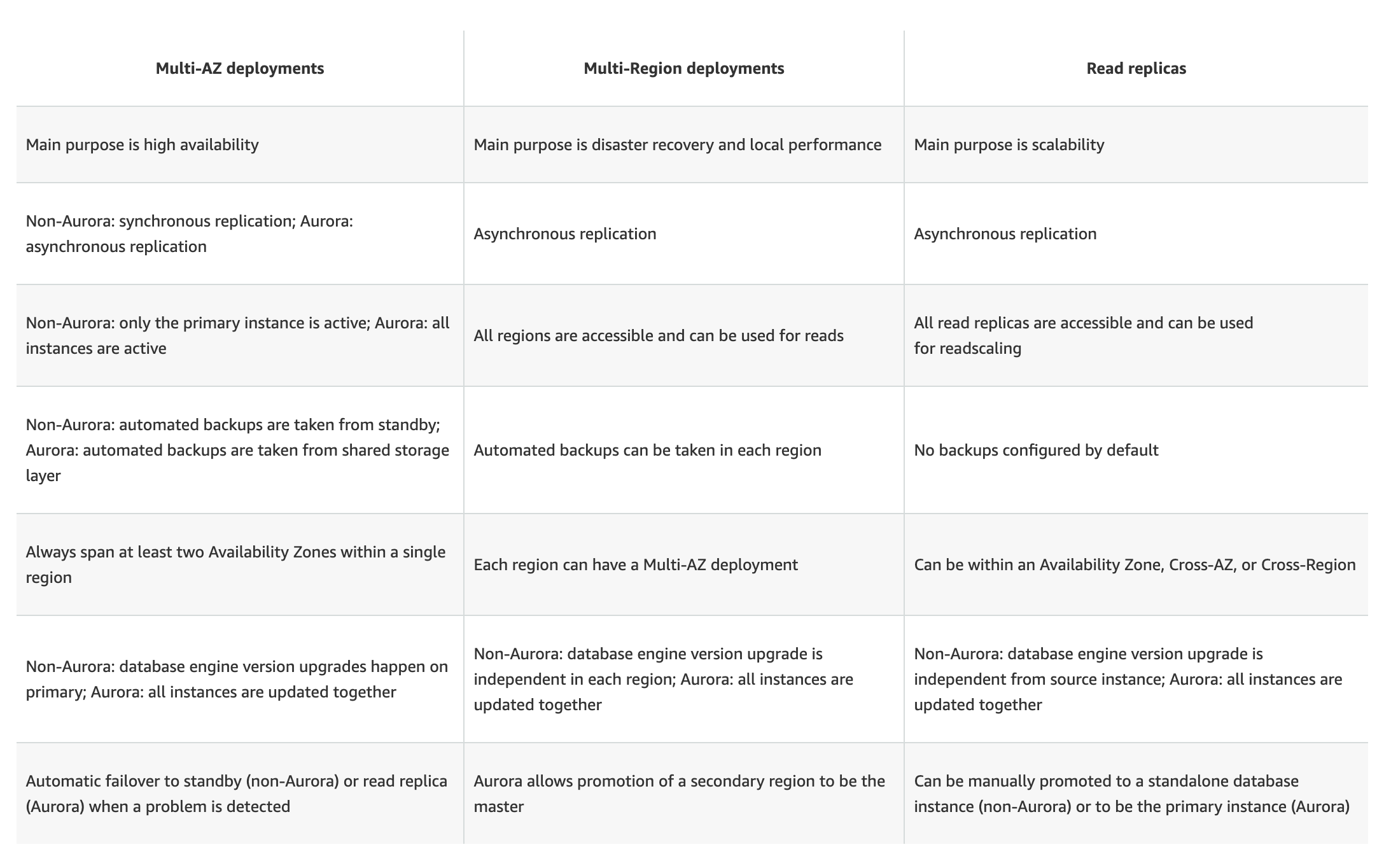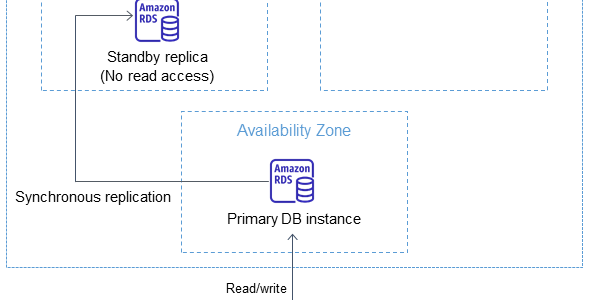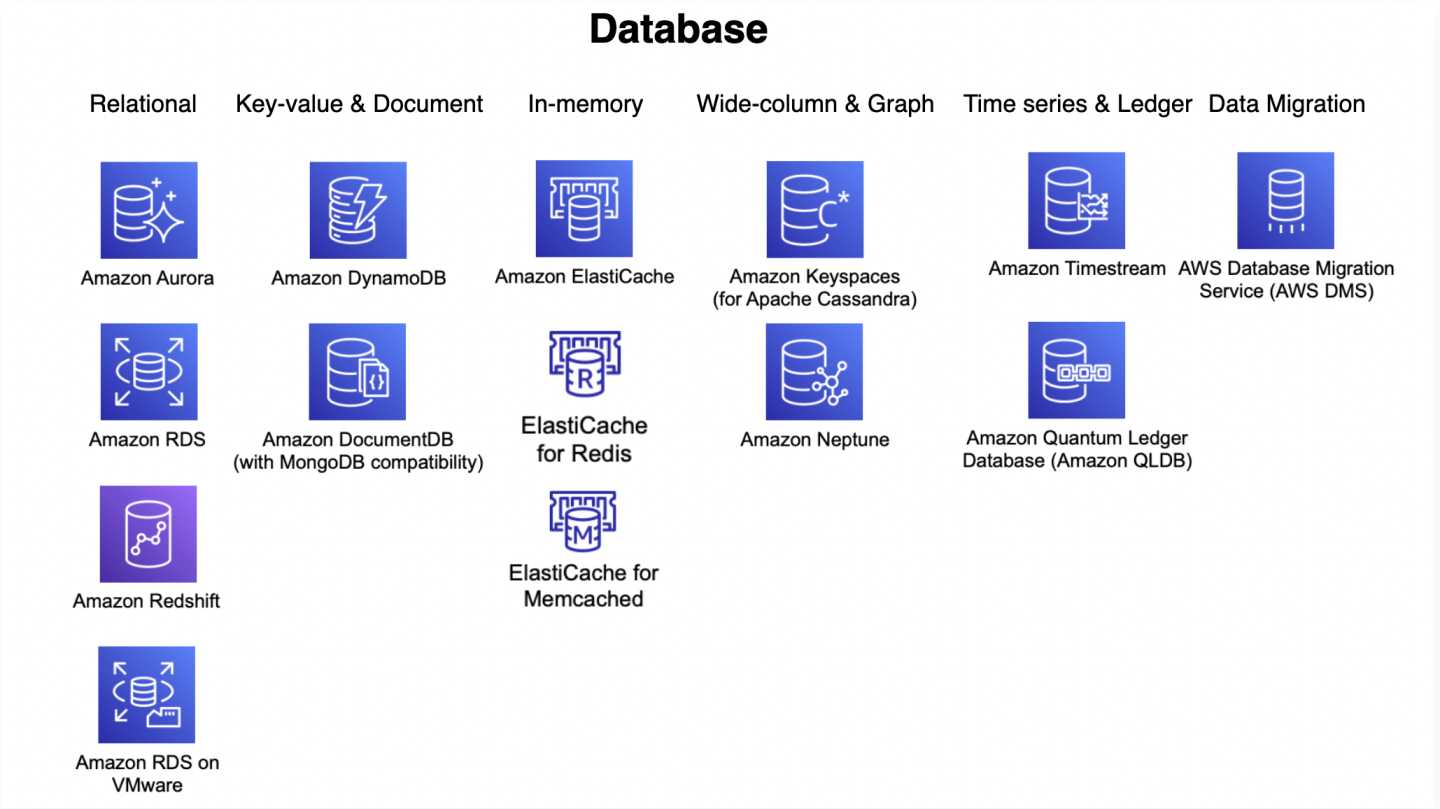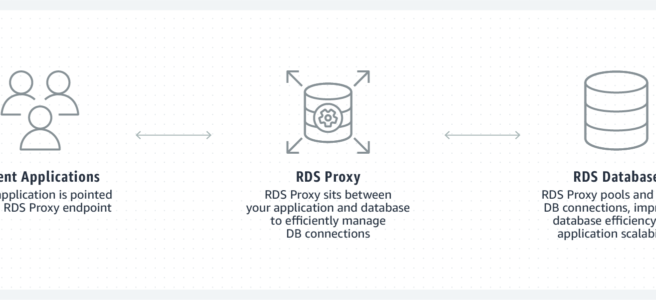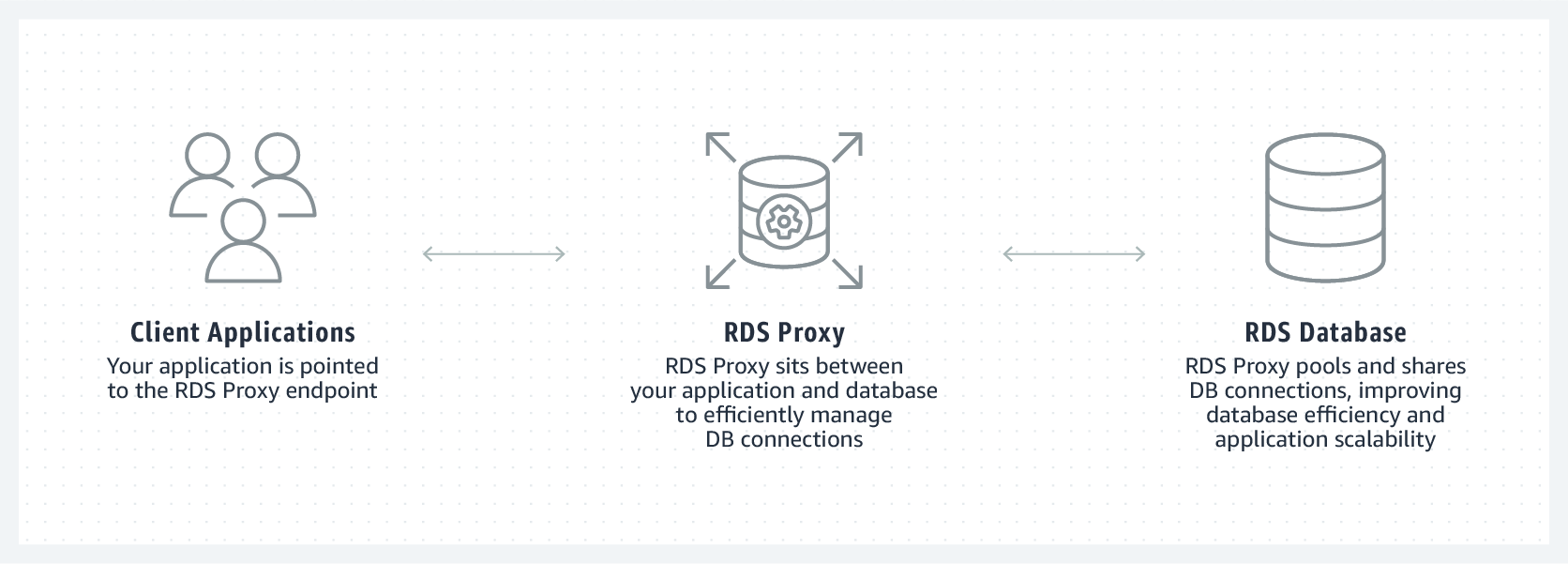AWS Storage Options Whitepaper with RDS, DynamoDB & Database on EC2 Cont.
Provides a brief summary for the Ideal Use cases, Anti-Patterns and other factors for Amazon RDS, DynamoDB & Databases on EC2 storage options
Amazon RDS
- RDS is a web service that provides the capabilities of MySQL, Oracle, MariaDB, Postgres or Microsoft SQL Server relational database as a managed, cloud-based service
- RDS eliminates much of the administrative overhead associated with launching, managing, and scaling your own relational database on Amazon EC2 or in another computing environment.
Ideal Usage Patterns
- RDS is a great solution for cloud-based fully-managed relational database
- RDS is also optimal for new applications with structured data that requires more sophisticated querying and joining capabilities than that provided by Amazon’s NoSQL database offering, DynamoDB.
- RDS provides full compatibility with the databases supported and direct access to native database engines, code and libraries and is ideal for existing applications that rely on these databases
Anti-Patterns
- Index and query-focused data
- If the applications don’t require advanced features such as joins and complex transactions and is more oriented toward indexing and querying data, DynamoDB would be more appropriate for this needs
- Numerous BLOBs
- If the application makes heavy use of files (audio files, videos, images, etc), it is a better choice to use S3 to store the objects instead of database engines Blob feature and use RDS or DynamoDB only to save the metadata
- Automated scalability
- RDS provides pushbutton scaling and it only scales up and has limited scale out ability. If fully-automated scaling is needed, DynamoDB may be a better choice.
- Complete control
- RDS does not provide admin access and does not enable the full feature set of the database engines.
- So if the application requires complete, OS-level control of the database server with full root or admin login privileges, a self-managed database on EC2 may be a better match.
- Other database platforms
- RDS, at this time, provides a MySQL, Oracle, MariaDB, PostgreSQL and SQL Server databases.
- If any other database platform (such as IBM DB2, Informix, or Sybase) is needed, it should be deployed on a self-managed database on an EC2 instance by using a relational database AMI, or by installing database software on an EC2 instance.
Performance
- RDS Provisioned IOPS, where the IOPS can be specified when the instance is launched and is guaranteed over the life of the instance, provides a high-performance storage option designed to deliver fast, predictable, and consistent performance for I/O intensive transactional database workload
Durability and Availability
- RDS leverages Amazon EBS volumes as its data store
- RDS provides database backups, for enhanced durability, which are replicated across multiple AZ’s
- Automated backups
- If enabled, RDS will automatically perform a full daily backup of your data during the specified backup window, and will also capture DB transaction logs
- User initiated backups
- User can initiate backups at time and they are not deleted unless deleted explicitly by the user
- RDS Multi AZ’s feature enhances both the durability and the availability of the database by synchronously replicating the data between a primary RDS DB instance and a standby instance in another Availability Zone, which prevents data loss,
- RDS provides a DNS endpoint and in case of an failure on the primary, it automatically fails over to the standby instance
- RDS also allows Read replicas for the supported databases, which are replicated asynchronously
Cost Model
- RDS offers a tiered pricing structure, based on the size of the database instance, the deployment type (Single-AZ/Multi-AZ), and the AWS region.
- Pricing for RDS is based on several factors: the DB instance hours (per hour), the amount of provisioned database storage (per GB-month and per million I/O requests), additional backup storage (per GB-month), and data transfer in/out (per GB per month)
Scalability and Elasticity
- RDS resources can be scaled elastically in several dimensions: database storage size, database storage IOPS rate, database instance compute capacity, and the number of read replicas
- RDS supports “pushbutton scaling” of both database storage and compute resources. Additional storage can either be added immediately or during the next maintenance cycle
- RDS for MySQL also enables you to scale out beyond the capacity of a single database deployment for read-heavy database workloads by creating one or more read replicas.
- Multiple RDS instances can also be configured to leverage database partitioning or sharding to spread the workload over multiple DB instances, achieving even greater database scalability and elasticity.
Interfaces
- RDS APIs and the AWS Management Console provide a management interface that allows you to create, delete, modify, and terminate RDS DB instances; to create DB snapshots; and to perform point-in-time restores
- There is no AWS data API for Amazon RDS.
- Once a database is created, RDS provides a DNS endpoint for the database which can be used to connect to the database.
- Endpoint does not change over the lifetime of the instance even during the failover in case of Multi-AZ configuration
Amazon DynamoDB
- Amazon DynamoDB is a fast, fully-managed NoSQL database service that makes it simple and cost-effective to store and retrieve any amount of data, and serve any level of request traffic.
- DynamoDB being a managed service helps offload the administrative burden of operating and scaling a highly-available distributed database cluster.
- DynamoDB helps meet the latency and throughput requirements of highly demanding applications by providing extremely fast and predictable performance with seamless throughput and storage scalability.
- DynamoDB provides both eventually-consistent reads (by default), and strongly-consistent reads (optional), as well as implicit item-level transactions for item put, update, delete, conditional operations, and increment/decrement.
- Amazon DynamoDB handles the data as below :-
- DynamoDB stores structured data in tables, indexed by primary key, and allows low-latency read and write access to items.
- DynamoDB supports three data types: number, string, and binary, in both scalar and multi-valued sets.
- Tables do not have a fixed schema, so each data item can have a different number of attributes.
- Primary key can either be a single-attribute hash key or a composite hash-range key.
- Local secondary indexes provide additional flexibility for querying against attributes other than the primary key.
Ideal Usage Patterns
- DynamoDB is ideal for existing or new applications that need a flexible NoSQL database with low read and write latencies, and the ability to scale storage and throughput up or down as needed without code changes or downtime.
- Use cases require a highly available and scalable database because downtime or performance degradation has an immediate negative impact on an organization’s business. for e.g. mobile apps, gaming, digital ad serving, live voting and audience interaction for live events, sensor networks, log ingestion, access control for web-based content, metadata storage for S3 objects, e-commerce shopping carts, and web session management
Anti-Patterns
- Structured data with Join and/or Complex Transactions
- If the application uses structured data and required joins, complex transactions or other relationship infrastructure provided by traditional database platforms, it is better to use RDS or Database installed on an EC2 instance
- Large Blob data
- If the application uses large blob data for e.g. media, files, videos etc., it is better to use S3 to store the objects and use DynamoDB to store metadata for e.g. name, size, content-type etc
- Large Objects with Low I/O rate
- DynamoDB uses SSD drives and is optimized for workloads with a high I/O rate per GB stored. If the applications stores very large amounts of data that are infrequently accessed, S3 might be a better choice
- Prewritten application with databases
- For Porting an existing application using databases, RDS or database installed on the EC2 instance would be a better and seamless solution
Performance
- SSDs and limited indexing on attributes provides high throughput and low latency and drastically reduces the cost of read and write operations.
- Predictable performance can be achieved by defining the provisioned throughput capacity required for a given table.
- DynamoDB handles the provisioning of resources to achieve the requested throughput rate, taking away the burden to think about instances, hardware, memory, and other factors that can affect an application’s throughput rate.
- Provisioned throughput capacity reservations are elastic and can be increased or decreased on demand.
Durability and Availability
- DynamoDB has built-in fault tolerance that automatically and synchronously replicates data across three AZ’s in a region for high availability and to help protect data against individual machine, or even facility failures.
Cost Model
- DynamoDB has three pricing components: provisioned throughput capacity (per hour), indexed data storage (per GB per month), data transfer in or out (per GB per month)
Scalability and Elasticity
- DynamoDB is both highly-scalable and elastic.
- DynamoDB provides unlimited storage capacity, and the service automatically allocates more storage as the demand increases
- Data is automatically partitioned and re-partitioned as needed, while the use of SSDs provides predictable low-latency response times at any scale.
- DynamoDB is also elastic, in that you can simply “dial-up” or “dial-down” the read and write capacity of a table as your needs change.
Interfaces
- DynamoDB provides a low-level REST API, as well as higher-level SDKs in different languages
- APIs provide both a management and data interface for Amazon DynamoDB, that enable table management (creating, listing, deleting, and obtaining metadata) and working with attributes (getting, writing, and deleting attributes; query using an index, and full scan).
Databases on EC2
- EC2 with EBS volumes allows hosting a self managed relational database
- Ready to use, prebuilt AMIs are also available from leading database solutions
Ideal Usage Patterns
- Self managed database on EC2 is an ideal scenario for users whose application requires a specific traditional relational database not supported by Amazon RDS for e.g. IBM DB2, Informix, or Sybase
- Users or applications that require a maximum level of administrative control and configurability which is not provided by RDS
Anti-Patterns
- Index and query-focused data
- If the applications don’t require advanced features such as joins and complex transactions and is more oriented toward indexing and querying data, DynamoDB would be more appropriate for this needs
- Numerous BLOBs
- If the application makes heavy use of files (audio files, videos, images, and so on), it is a better choice to use S3 to store the objects instead of database engines Blob feature and use RDS or DynamoDB only to save the metadata
- Automated scalability
- Relational databases on EC2 leverages the scalability and elasticity of the underlying AWS platform, but this requires system administrators or DBAs to perform a manual or scripted task. If you need pushbutton scaling or fully-automated scaling, DynamoDB or RDS may be a better choice.
- RDS supported database platforms
- If the application using RDS supported database engine and all the features are available, RDS would be a better choice instead of self managed relational database on EC2
Performance
- Performance depends on the size of the underlying EC2 instance, the number and configuration of the EBS volumes and the database itself
- Performance can be increased by scaling up memory and compute resources by choosing a larger Amazon EC2 instance size.
- For database storage, it is usually best to use EBS Provisioned IOPS volumes. To scale up I/O performance, the Provisioned IOPS can be increased, the number of EBS volumes changed, or use software RAID 0 (disk striping) across multiple EBS volumes, which will aggregate total IOPS and bandwidth.
Durability & Availability
- As the database on EC2 uses EBS as storage, it has the same durability and availability provided by EBS and can be further enhanced by using EBS snapshots or by using third-party database backup utilities (such as Oracle’s RMAN) to store database backups in Amazon S3
Cost Model
- Cost for running a database on EC2 instance is mainly determined by the size and the number of EC2 instance running, the size of the EBS volume used for database storage and any third party licensing cost for the database
Scalability & Elasticity
- Users of traditional relational database solutions on Amazon EC2 can take advantage of the scalability and elasticity of the underlying AWS platform by creating AMI and spawning multiple instances
AWS Certification Exam Practice Questions
- Questions are collected from Internet and the answers are marked as per my knowledge and understanding (which might differ with yours).
- AWS services are updated everyday and both the answers and questions might be outdated soon, so research accordingly.
- AWS exam questions are not updated to keep up the pace with AWS updates, so even if the underlying feature has changed the question might not be updated
- Open to further feedback, discussion and correction.
- Which of the following are use cases for Amazon DynamoDB? Choose 3 answers
- Storing BLOB data.
- Managing web sessions
- Storing JSON documents
- Storing metadata for Amazon S3 objects
- Running relational joins and complex updates.
- Storing large amounts of infrequently accessed data.
- A client application requires operating system privileges on a relational database server. What is an appropriate configuration for highly available database architecture?
- A standalone Amazon EC2 instance
- Amazon RDS in a Multi-AZ configuration
- Amazon EC2 instances in a replication configuration utilizing a single Availability Zone
- Amazon EC2 instances in a replication configuration utilizing two different Availability Zones
- You are developing a new mobile application and are considering storing user preferences in AWS, which would provide a more uniform cross-device experience to users using multiple mobile devices to access the application. The preference data for each user is estimated to be 50KB in size. Additionally 5 million customers are expected to use the application on a regular basis. The solution needs to be cost-effective, highly available, scalable and secure, how would you design a solution to meet the above requirements?
- Setup an RDS MySQL instance in 2 availability zones to store the user preference data. Deploy a public facing application on a server in front of the database to manage security and access credentials
- Setup a DynamoDB table with an item for each user having the necessary attributes to hold the user preferences. The mobile application will query the user preferences directly from the DynamoDB table. Utilize STS. Web Identity Federation, and DynamoDB Fine Grained Access Control to authenticate and authorize access (DynamoDB provides high availability as it synchronously replicates data across three facilities within an AWS Region and scalability as it is designed to scale its provisioned throughput up or down while still remaining available. Also suitable for storing user preference data)
- Setup an RDS MySQL instance with multiple read replicas in 2 availability zones to store the user preference data .The mobile application will query the user preferences from the read replicas. Leverage the MySQL user management and access privilege system to manage security and access credentials.
- Store the user preference data in S3 Setup a DynamoDB table with an item for each user and an item attribute pointing to the user’ S3 object. The mobile application will retrieve the S3 URL from DynamoDB and then access the S3 object directly utilize STS, Web identity Federation, and S3 ACLs to authenticate and authorize access.
- A customer is running an application in US-West (Northern California) region and wants to setup disaster recovery failover to the Asian Pacific (Singapore) region. The customer is interested in achieving a low Recovery Point Objective (RPO) for an Amazon RDS multi-AZ MySQL database instance. Which approach is best suited to this need?
- Synchronous replication
- Asynchronous replication
- Route53 health checks
- Copying of RDS incremental snapshots
- You are designing a file -sharing service. This service will have millions of files in it. Revenue for the service will come from fees based on how much storage a user is using. You also want to store metadata on each file, such as title, description and whether the object is public or private. How do you achieve all of these goals in a way that is economical and can scale to millions of users?
- Store all files in Amazon Simple Storage Service (53). Create a bucket for each user. Store metadata in the filename of each object, and access it with LIST commands against the S3 API.
- Store all files in Amazon 53. Create Amazon DynamoDB tables for the corresponding key -value pairs on the associated metadata, when objects are uploaded.
- Create a striped set of 4000 IOPS Elastic Load Balancing volumes to store the data. Use a database running in Amazon Relational Database Service (RDS) to store the metadata.
- Create a striped set of 4000 IOPS Elastic Load Balancing volumes to store the data. Create Amazon DynamoDB tables for the corresponding key-value pairs on the associated metadata, when objects are uploaded.
- Company ABCD has recently launched an online commerce site for bicycles on AWS. They have a “Product” DynamoDB table that stores details for each bicycle, such as, manufacturer, color, price, quantity and size to display in the online store. Due to customer demand, they want to include an image for each bicycle along with the existing details. Which approach below provides the least impact to provisioned throughput on the “Product” table?
- Serialize the image and store it in multiple DynamoDB tables
- Create an “Images” DynamoDB table to store the Image with a foreign key constraint to the “Product” table
- Add an image data type to the “Product” table to store the images in binary format
- Store the images in Amazon S3 and add an S3 URL pointer to the “Product” table item for each image

